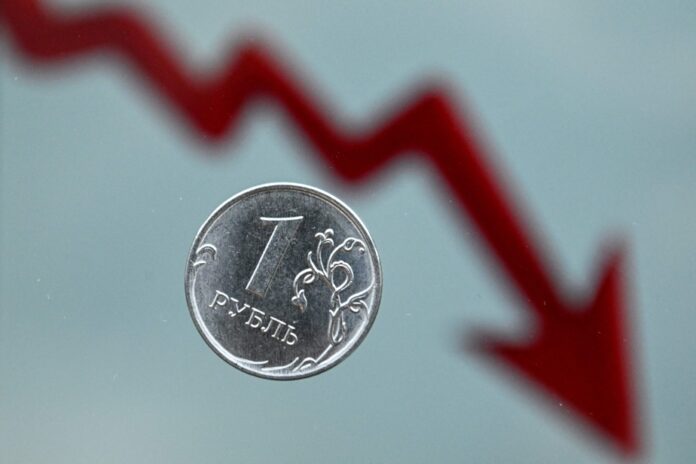With the ruble at a 16-month low against the U.S. dollar, sparking fears of rising inflation, even one of President Vladimir Putin’s staunchest defenders publicly lashed out at the authorities financial institutions over an exchange rate he says is the subject of global ridicule.
Russia’s central bank took action on Thursday to stabilize the currency, amid the latest wave of financial volatility sparked by Putin’s war on Ukraine. This time around, the challenges are visible both in the weaker ruble that is fueling inflation, but also in government budget deficits that raise concerns about Russia’s continued war-intensive spending.
The weakening ruble approached an exchange rate of 100 to the US dollar this week, down about 25% since the start of the year. The decline prompted the Bank of Russia on Thursday to halt foreign currency purchases for the rest of the year “to reduce volatility.”
The move should help support the ruble because when the bank spends rubles to buy foreign currency, it increases the supply of rubles in circulation, which lowers their value. The ruble remained roughly stable in Thursday’s trading.
But these trends demonstrate that the evolving Russian economy is testing Moscow’s financial policymakers, who have responded nimbly to the shocks of war but still face longer-term dilemmas. Gaping deficits, coupled with increasingly sanctioned exports, have disrupted Russia’s economic balance.
“The ruble exchange rate is just an indicator,” said Alexandra Prokopenko, a researcher at the Carnegie Russia Eurasia Center and a former Russian central bank official. “It tells us that the economy is very unbalanced, that it’s not working properly – and that something has to be done, because later it will be worse,” she adds.
It is unclear to what extent Thursday’s decision by the Bank of Russia will support the ruble.
Janis Kluge, a researcher specializing in Russian economics at the German Institute for International and Security Affairs, believes that “it helps, but it’s not a game-changer. What is more important is the evolution of commodity prices and the evolution of tax expenditures over the next few months.”
Since Putin’s invasion of Ukraine at the end of February 2022, Russia has been on an economic roller coaster.
An onslaught of Western sanctions and a dramatic exodus of capital and assets plunged the country into crisis in the aftermath of the invasion. The ruble collapsed from 76 to the dollar a week before the invasion to 135 the following month. The central bank has taken a series of drastic measures, including strictly limiting the outflow of money from the country, in order to avoid a real collapse.
Then the situation changed. Soaring oil prices, due in part to the conflict, helped boost Russia’s export earnings, even as imports declined due to reluctant Russian consumers, withdrawal of foreign companies and other factors. This resulted in a record trade surplus of $221 billion in 2022, up 86% from the previous year. The ruble flip-flopped and soared to its highest level in seven years.
But this year, Russia’s trade surplus has narrowed considerably. Imports have picked up as Russian consumers start buying again, and the government is pumping billions into the military-industrial complex to finance the war, while many goods still require imported materials.
Oil revenues have been reduced by an embargo and a price cap, while crude prices have fallen from the highs reached last year. Political uncertainty, including an aborted June mutiny by mercenary tycoon Yevgeny Prigozhin, prompted Russians to transfer money to overseas accounts.
It is the second time since the beginning of the war that Russia has been forced to abandon a policy of regularly buying and selling foreign currencies, in order to isolate the country’s economy, which depends on energy, fluctuations in the price of oil.
Vladimir Solovyov, a state TV host and Kremlin defender, blasted the weakening ruble this week, asking the central bank to explain “why the exchange rate is jumping like this, which causes laughter abroad”.
He also addressed the country’s lawmakers: “Haven’t you noticed the exchange rate we have in the country? Did you send even one request to the central bank? Let these people come and explain to the Russians what is going on! »
The most immediate concern of Russian financial policymakers is the possibility of a significant rise in consumer prices. The central bank reacted to this risk late last month by raising interest rates more than expected, to 8.5%, and further increases may follow.
On his show, Mr Solovyov warned that the rate of inflation could peak during Mr Putin’s re-election campaign, ahead of the vote scheduled for next March.
Some analysts, including Chris Weafer, managing director of Eurasia Macro-Advisory, believe Russian financial authorities are deliberately letting the ruble weaken.
“The ruble’s weakness reflects the government’s concern about the level of budget revenue – and there aren’t many areas where they can cut the budget without impacting the military or the social stability that the we are currently seeing in Russia, Mr. Weafer said. So the lesser of two evils is to let the ruble weaken. »
But others do not believe that Russia exercises such control.
“I don’t think the Russian Finance Ministry wants to weaken the rouble, despite the positive effect on short-term revenue,” Kluge said. Inflation also increases spending. For example, pensions will have to be increased accordingly, even if with some delay. »















